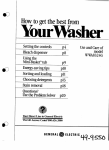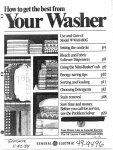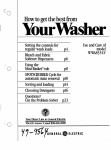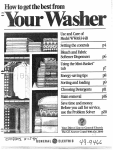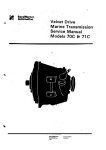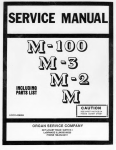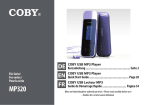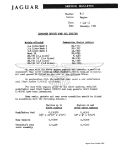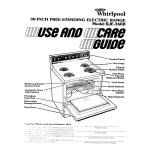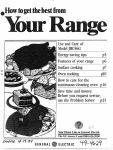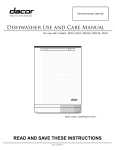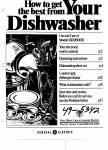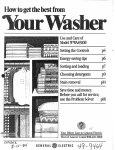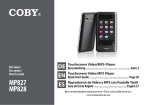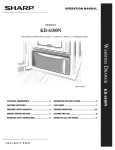Download GE WWA8324B User's Manual
Transcript
Howtogetthebestfrom
c
r
You
UseandCareof
ModelWW!A8324B
--- - ..
...
‘+
..4
Settingthe Controls
p4
BleachDispenser
p6
UsingtheMini-Baske~
tub
p7
Energy-satigtips
I@
Sortingandloading
p9
1
/..
ChoosingDetergents
pll
Stainremoval
p16
Savetimeandmoney
Beforeyoucallforservice,
usetheProblemSolver p20
Your Direct Line to General Electric
The GE Answer CenteF800.626.2000
GENERAL
@ELECTRIC
+q-q+~s
Help us
help you...
Contents
Safety Instructions
3-4
Setting the Controls
4-5
Read this Use and Care
Book carefully
Itwill help you operate and
maintain your new washer
properly.
Write down the model and serial,.
numbers.
You’ll find them on a label on the
lower left side near the front.
How To Use
Bleach Dispenser
6
How To Use Mini-Basket~
Tbb
7
Energy-Saving Tips
8
Good Sorting Means Better
washing
9
If you don’t understand something
or-need more help . . .Call, toll free;
These numbers are also on the
Consumer Product Ownership
Registration Card that came with
your washer. Before sending in
this card, please write these
numbers here:
It Pays to Check and
Pre-treat
9
The GE Answer CenterTM
800.626.2000
consumer information service
Model No.
soaking
9
How To Load Your Washer
10
What is the Best Size Load
of Clothes?
10
Factors To Consider in
Selection of Detergents
and Soap
11
The Damaging Effects of
Carbonate Detergents on
Your Clothes and Washer
n
Keep it handy for answers to your
questions.
or write (include your phone
number):
Consumer Affairs
General Electric Company
Appliance Park
Louisville, KY 40225
Serial No.
Use these numbers in any
correspondence or service calls
concerning your washer.
If you received a damaged washer,
immediately contact the dealer (or
builder) that sold you the washer.
Save time and money . . .
before you call for service
Check the Problem Solver (pages ,/
20-25). It lists minor causes of
‘ ~.
operating problems that you can
correct yourself. It could save you
an unnecessary service call.
How Much Detergent or Soap 13
Should You Use?
How To Use Detergent
or Soap
13
Hard Water—Do You
Have It?
14
Other Laundry Products
15
How To Remove Stains
16-17
Washing Guide for
18-39
Different Fabrics and Loads
The Problem Solver
20-25
How To Care for
Your Washer
26
Consumer Services
27
Warranty
Back Cover
FOR YOUR SAFETY
FOR YOUR SAFETY
If you smell gas:
1. Open windows
2. Don’t touch
electrical switches
3. Extinguish any open
Do not store or use
gasoline or other
flammable vapors and
liquids in the vicinity of
this or any other
appliance.
flame
.
4. Immediately call
your gas supplier
2
Important Safety Instructions-SAVE THESE
[INSTRUCTIONS
Read all instructions before using this appliance
4--I.,J
WARNING—When using this
appliance, always exercise basic
safety precautions, including the
following:
c Use this appliance only for its
intended purpose as described in
this Use and Care Book.
This washer must be properly
installed and located in
accordance with the Installation
Instructions before it is used. If
you did not receive an Installation
Instructions sheet with your
washer, you can obtain one by
contacting the service location
nearest you.
●
Properly ground to conform
with all governing codes
and ordinances.
Install or store where it will not
be exposed to temperatures
below freezing or exposed to
the weather.
Connect to a properly rated,
protected and sized powersupply circuit to avoid electrical
overload.
Connect to adequate plumbing
and drain facilities as described
in the Installation Instructions.
Turn off water faucets when the
washer is not in use to relieve
pressure on hoses and valves, and
to minimize leakage if a hose or
valve should break or rupture.
● When disconnecting this
appliance pull by the plug rather
than the cord to avoid damage to
the cord or junction of cord and
plug. Make sure that the cord is
located so that it will not be
stepped on, tripped over or
otherwise subjected to damage
or stress.
● We strongly recommend that
any servicing be performed by
a qualified individual.
● The wiring diagram for this
machine is located inside the
control panel.
To minimize the possibility
of injury:
● Do not mix chlorine bleach with
ammonia or acids such as vinegar
and/or rust remover. Mixing can
produce a toxic gas which may
cause death.
c Do not wash or dry articles that
have been cleaned in, washed in,
soaked in, or spotted with
combustible or explosive
substances (such as gasoline,
degreasers, dry-cleaning solvents,
kerosene, etc.) which may give off
vapors that could ignite or
explode.
Do not add these substances to the
wash water.
Do not use these substances
around your washer and/or dryer
during operation.
● HYDROGEN
GAS is produced
by the chemical action within your
water heater and the gas can
accumulate in the water heater
and/or water pipes if hot water has
not been used for a period of two
weeks or longer. HYDROGEN
GAS CAN BE EXPLOSIVE
UNDER THESE CIRCUMSTANCES. So to prevent the
possibility of damage or injury, if
you have not used hot water for
two weeks or more, or move into
a residence in which the hot water
system may not have been used for
some time, turn on all hot water
faucets and allow them to run for
several minutes before using any
electrical appliance which is connected to the hot water system.
This will allow any hydrogen gas
to escape. Of course, since the gas
is flammable, do not smoke or use
an open flame or appliance during
this process.
● Never reach into the washer
while it is moving. Before loading,
unloading or adding clothes, push
in the Cycle Selector knob to
“STOP” position, then wait until
the machine has completely
stopped before opening the lid.
● Close supervision is necessary
if this appliance is used by or near
children. Do not allow children to
play inside, on, or with this appliance or any discarded appliance.
Dispose of discarded appliances
and shipping or packing materials
properly. Before discarding a
washer or removing from service,
remove the washer lid.
● Keep all laundry aids (such as
detergents, bleaches, fabric softeners, etc.) out of the reach of
children, preferably in a locked
cabinet. Observe all warnings on
container labels to avoid personal
injury.
● Keep the area around and underneath your appliances free from
the accumulation of combustible
materials, such as lint, paper, rags,
chemicals, etc.
● Keep the floor around your
appliances clean and dry to reduce
the possibilityy of slipping.
● To minimize the possibility of
electric shock, unplug this appliance from the power-supply before
attempting any maintenance or
cleaning (except the removal and
cleaning of the lint filter). NOTE:
Turning the Cycle Selector knob to
an OFF position does NOT disconnect the appliance from the
power-supply.
Continued on next page
Important Safety Instructions
(continued)
●
Do not tamper with controls.
Do not operate this appliance if
it is damaged, malfunctioning,
partially disassembled, or has
missing or broken parts, including—
a damaged cord or plug.
●
● Do not wash fiberglass articles in
your washer. Skin irritation could
result from the remaining particles
that may be picked up by clothing
during subsequent washer use.
● The laundry process can reduce
the flame retardancy of fabrics. To
avoid such a result, the garment
manufacturer’s care instructions
should be followed very carefully.
For Washer Operation
Y’
c Do not leave washer lid up
during cycle. This will stop the
wash and spin action and prevent
completion of the cycle.
● Never climb on or stand on the
washer top.
How to operate your clothes washer
,., ..,,,,,.,..,,,.,. ....
II
z
cycle
SPEED
%
r-n
‘
Y“’
.:
5<1 . .
I
,~~:
C: V(:I1,
.
(, ENTLE
‘)Pr
,,, ,!!,
[ [>
/
@‘~
/
~,, ,!,
M HMA,
Sorting and Loading
● Sort clothes carefully by fabric
type, weight, color and amount of
soil according to instructions on
page 9.
● Remove Filter-Flo”
pan and
Mini-Basketl° tub. The underside
of the lid is a good place to put the
pan while loading or unloading
clothes.
for information on detergents and
other laundry additives.
NOTE: Do not use the Filter-Flo
pan as a wash basket. Do not put
any items to be washed in the
Filter-Flo pan.
See page 6 for information on
how to use Bleach Dispenser. For
information on bleaches and fabric
softeners, see page 15.
●
● Close lid, washer will fill but not
agitate or spin with lid open.
❑ Select Wash and
H1 AVY
T“T
Rinse Tem-
perature.
❑ Push
Cycle Selector Knob in
and turn clockwise to your selected
wash setting.
-
Regular Cycle automatically provides Normal Wash Speed and
Normal Spin Speed.
Perm Press& Knits Cycle
automatically provides Gentle
Wash Speed and Gentle Spin
Speed.
Setting the Controls
Use the Controls Setting Guide on
5 to help you make the proper
selections.
page
Do not use Mini-Basket tub when
washing regular loads. You’ll find
complete details on how and when
to use the Mini-Basket tub on
page 7.
● Load clothes into the wash
basket being careful not to overload. Clothes should be below the
retaining ring. See page 10 for
more loading information.
❑ Select Water Level
SMALL: Washer is less than
1/2full of clothes.
MEDIUM: Between !/zand
2/3 full.
LARGE: over V3’sfull.
MINI-BASKET: See instructions
on page 7.
● Position Filter-Flo pan on agitator and add measured amount of
detergent. See pages 11through 14
4
❑ Pull Cycle Selector Knob
out
to start the washer. If you wish to
change setting after washer has
started, push Cycle Selector Knob
in to stop the washer and reset to
the new position. Setting can be
changed at any time.
‘.u-
Controls Setting Guide
Some adjustment to these recommendations may be desirable depending on your particular washing conditions.
i
,
Cottons & Linens
.
Permanent Press
Polyester Knits
Synthetics & Blends
Fabric
Work clothes,
dungarees, etc.
with heavy soil
Work clothes,
dungarees, etc.
with normal soil
White or
Colorfast
Bright
Colors
Heavy or
Oily Soil
Normal or
Light Soil
Heavy or
Oily Soil
Normal or
Light Soil
Wash/Rinse
Temperature
Hot/Cold
Hot/Cold or
Warm/Cold
;a;:;:o;
Warm/Cold
Hot/Cold
Warm/Cold
Warm/Cold
Warm/Cold
Normal
Soil
Normal Soil
or Light
Regular Cycle
Perm Press & Knits Cycle
Normal Soil—
for small loads.
Cycle Selector
Setting
Heavy Soil—
for all other loads
Normal
Soil
Normal or
Light Soil
Normal or
Light Soil
Normal
Soil
Normal Soil
or Light
Tips to Help You Select Settings
Regular Cycle—
Perm. Press&
Knits Cycle—
/,f
N,*MA,
1
.>(,
For most cottons, linens,
\vork and play
clothes. Three
soil level settings
{
are provided,
but you can set the selector inbetween, if desired. Selection of
these settings automatically
provides for Normal Wash Speed,
Fast Spin.
For Polyester
Knits, delicates and
./
permanent press.
}
An extended cooldown spray rinse is ““’u
provided to minimize the setting of
wrinkles. Selection of these settings
automatically provides for Gentle
Speed Wash, Slow Spin.
What Happens
(Approximate
in Each Setting
Regular Cycle
Normal Speed Wash, Fast Spin
I Cycle
I Selector
Heavy
Normal
\ Settings
Wash
18
14
Light
Soil
Soak
6
Spin
3 ‘/2
3 Y2
3 1/2
Rinse
3 ‘/2
3 1/2
3 1/2
Spin
7
7
Total
Time
34
30
U!>H7
d)
/
Soak Setting—
Use i;ith most soaking aids to
loosen embedded soils and stains.
See page 6.
>
(
Rl, [,,,,, +l
(;”( 1(,
N, )+<r..
~,1 I ,
Minutes)
Perm. Press & Knits Cycle
Gentle Speed Wash. Slow Sc)in
Normal
Soil
Light
10 1/2
3 ‘/2
2 1/2
2 Y2
3 ‘/2
3 ‘/2
3 ‘/2
7
7
4 Yz
4 1/2
22
11
23
‘/2
~
Rinse
~Spin
Starts Here
Starts Here
16 Y2
J
NOTES: . Total time includes
. Total
time
household
pauses between each phase of cycle.
water fill time. Fill times vary depending
water pressure and your selected water level.
does
not include
5
on
How to Use the
Bleach Dispenser
How to Use
the Soak Setting
# -
O!F
Regular
Cycle
NOflMAL
SPEED
SOAK .*
24
%
(w
/
NORMAL I
● Use this dispenser with liquid
bleach only. If you prefer to use
powdered bleach, pour it into the
Filter-Flo pan or wash basket
along with your detergent. Do not
put powdered bleach into the
bleach dispenser.
● Measure bleach carefully. Here
are some recommended amounts:
LARGE WASH-1 % cup (310 ml)
liquid
SMALL WASH-% cup (170 ml)
liquid
MINI-BASKET tub- ?4 cup (60 ml)
liquid
Pour measured amount of liquid
bleach directly into bleach
dispenser.
●
● Do not overfill or allow
dispenser to overflow. Avoid
splashing. Undiluted bleach can
cause fabric damage.
HEAVY\
.
● “SOAK” setting temperature
will automaticall~be cold.
QIf a hot or warm soak is desired,
set the WASH/RINSE TEMPERATURE switch to “HOT/COLD”
or “WARM/COLD” and turn the
Cycle Selector Knob to “Normal”
in the Regular Cycle. Start the
washer. After washer fills and
begins to agitate, push in the Cycle
Selector Knob and turn to
“SOAK:’ Pull out the Cycle
Selector Knob to complete the
cycle.
●
For an extended soak allow the
washer to fill and agitate for a few
minutes to dissolve the soaking
agent. Then push in the Cycle
Selector Knob to stop the washer
(keep lid closed) and allow to soak
for as long as desired. After
desired soak period, pull out the
Cycle Selector Knob to complete
the cycle.
● Never pour undiluted
liquid
bleach directly onto clothes or
into the wash basket or MiniBasket tub.
6
,,
‘-G
How to Use the
Min.i-BasketTM
tub.
.,-..
Types of loads which can be
washed in the Mini-Basket Tub.
Here’s how to use the Mini-Basket
tub:
● Small loads of regular fabrics . . .
up to 21Apounds.
●
s Delicate loads such as lingerie,
panty hose, girdles, blouses,
sweaters, socks, shirts, baby
clothes and other small delicate
hand washables.
●
Remove Filter-Flo pan.
● Put 1Ato 1Acup (60 to 80 ml)
detergent in Filter-Flo pan.
● To use Bleach Softener
Dispenser, see page 6.
● Close lid and set controls as
follows:
Water
.
Stuffed toys.
MEDIUM
Level
LARGE
c Tennis shoes.
Some special instructions to
remember when you use the MiniBasket Tub.
Do not wash clothes in the
regular basket when using the
Mini-Basket tub.
●
Do not use the Mini-Basket tub
with the Soak Setting.
●
When washing stockings, panty
hose and other easily tangled
items, always handle separately. To
minimize tangling, the use of a net
laundry bag is recommended.
●
I
\
::: SMALL
@
MINI
BASKET
‘3
. Place Mini-Basket tub on
agitator. Pull the agitator toward
the front of the machine for easier
installation and removal of MiniBasket tub.
—Select desired Wash/Rinse Temperature and Cycle. See page 4.
● Load clothes in Mini-Basket tub.
See page 9 sorting help.
—Pull out Cycle Selector Knob to
start washer.
—Set Water Level to “MINIBASKET” position
Ss4———I
. After loading clothes in the MiniBasket tub, be sure to replace the
Filter-Flo pan. The pan serves as a
lid to keep the clothes in the MiniBasket tub.
Energy-Saving Tips
We are all conscious of the need
to save energy—to protect our
country’s energy reserves and to
help us save money. There are
several things you can do to reduce
the amount of energy needed to
wash your clothes:
1. Use Hot Wash-140° (60°C)—
on a regular bask only when
washing heavily soiled
articles-such as work and play
clothes.
2. Under normal soil conditions,
wash in water above 80°F (27”C).
This generally means using the
Warm Wash temperature setting
on your washer-temperatures
approximately 95 ‘F (35‘C). If you
notice that soil has accumulated
after several consecutive washings,
use Hot Wash occasionally, if safe
for fabrics.
3. Try to wash less often. Save
articles of the same type of fabric
until you have a full load.
4. If you must wash smaller loads,
adjust the amount of water. Small
loads should have lower water
levels.
5. Wash in off-peak utility hours.
Your local utility can tell you
which are the off-peak hours.
6. Use your washer’s Normal
Speed Spin. You can save energy
on the Gentle Cycle by switching
from Gentle Spin to Regular
Cycle/Normal Speed Spin. This
will remove more water during
spin, which will shorten drying
cycle to save more energy. The
drying will remove any wrinkles
which may result from the Normal
Spin.
7. Use your Mini-Basket~ tub for
very small loads. It uses less water
than the small water level in the big
tub on this washer. You will also
save on detergent and energy.
‘:
8
IMPORTANT NOTE: If Your
clothes and household items don’t
look clean and fresh after washing,
what are you apt to do? You will
probably then re-wash them . . .
and that means you’ll waste
energy. Remember to sort your
clothes carefully, and load them
properly, select correct cycles, use
enough detergent and choose a
water temperature warm enough
to release and get rid of soil.
~
,,, ‘,
~1.#
Good sorting means better washing
e.. \%
,,
%-’
Sort by surface texture
Sort by soil
Separate
Separate
It pays to check and
prepare clothes for washing.
.
Lightly
Soiled
\3
from
from
\Colk4b~
from
LINT PRODUCERS—such as
terry toweling and chenille—give
up lint.
LINT COLLECTORS—such as
man-made fibers and napped
fabrics like velveteen and corduroy
—attract lint. These must be
washed separately.
FOR MORE INFORMATION
ON LINT CONTROL, SEE
PAGE 20.
Soaking & Pre-treating—
a good way to loosen
deep soils and stains.
Sort by color
Separate
Sort by fabric
from
.-..
from
from
●
Permanent
Press &
Blends
m
from
from
.
Synthetics
&
Poly Knits
13
from
_
~Delicates/
:$
&
—
● Empty pockets, brush out cuffs,
zip zippers, snap snaps, hook
hooks and button buttons.
● Do any necessary mending—
rips, hems, tears.
s Check all items for areas of
heavy soil or stain.
● Remove stains. FOR STAIN
REMOVAL CHART, SEE
PAGE 16.
● Turn Poly Knits inside-out to
minimize fabric surface damage.
FOR INSTRUCTIONS ON
DIFFERENT FABRICS AND
LOADS, SEE PAGES 18 and 19.
In addition to sorting to reduce lint
collection, it is reco&nended that
fabrics of similar construction be
washed together whenever possible.
9
A thorough soaking with detergent
or special soaking agent is an excellent way to remove heavy soils,
embedded dirt and even some
stains.
Soaking can be either a completely
separate washing step or a preliminary step to a complete wash cycle.
For detailed information on how
to soak in your washer, please see
page 6.
FOR INFORMATION ON
SOAKING AGENTS, SEE
PAGE 15.
● Pre-treat heavy soil by rubbing
in a small amount of liquid
detergent or a paste made of water
and powdered detergent or soap.
For best results wait !ZZhour
before washing.
How to load your washer
Special recommendations for
washing permanent press if you
do not have a dryer.
A
If you are machine-washing
Permanent Press clothes that you
plan to hang or drip-dry, use extra
care to minimize wrinkling in the
wash process:
_A
1+
“.L
● Be careful not to overload
washer. Permanent Press clothes
must have ample room to move
freely. A Medium size Permanent
Press load is the largest that should
be washed.
● Use more water than you would
for a regular load. Use a Medium
Water Level for a Small Load; a
Large Water Level for a Medium
Load.
● Remove clothes as soon as
washer stops and hang
immediately.
$-5.
k’
●
Load clothes dry.
● Take a properly sorted group of
clothes and drop them loosely in
the wash basket in this order:
o
Large Items —like sheets. Do not
wrap around the agitator.
Small Items—like washcloths.
Medium Size Items—like towels.
Here is a typical full load:
3 Double Sheets
6 Long Sleeve Shirts
3 Boxer Shorts
6 Standard Pillow Cases
5 T-shirts
4 Pair Trousers
6 Handkerchiefs
This illustration with clothes just
reaching the Clothes Retaining
Ring, shows a proper load. Clothes
have ample room to move because
they are not packed down, nor
wrapped around the agitator.
Clothes are loaded dry since wet
items are apt to pack down which
encourages overloading. This size
load requires a full water fill.
What is the best size load of
clothes—large, medium, or small?
Save time, energy and detergent
by avoiding extra use of the
washer. Try to wash a full load of
clothes. If you can it is better to
save clothes until you have a full
load. If you must wash smaller
loads, save water, energy and
detergent by adjusting the water
level for the size of the load. See
page 4.
To add items after the washer has
started.
●
●
●
●
Turn off the washer.
Carefully remove the Filter-Flo
pan.
Add any additional articles by
submerging next to the agitator.
Replace the Filter-Flo pan and
restart the washer.
NOTE: Do not use the Filter-Flo
pan as a wash basket. Do not put
any items to be washed in the
Filter-Flo pan.
NOTE: When washing stockings,
panty hose and other easily tangled
items, always handle separately. To
minimize tangling, the use of a net
laundry bag is recommended.
,,,m$
.’
9
10
Factors to consider in selection of detergents and soap.
Products:
Advantages:
Disadvantages:
Phosphate—
Powdered Detergents
Perform well in hard or soft
water.
Are not available in some
areas.
c=%
--
Wash all types of fabrics well.
Can be used in hot, warm, or
cold water.
Non-Phosphate—
Powdered Detergents
Perform satisfactorily in soft
or moderately hard water.
Generally do not clean well in
hard water.
In some areas only nonphosphate products are
available.
May be difficult to dissolve,
especially in cold water.
Should not be used in cold
water.
Those containing sodium
carbonate as an ingredient may
cause harmful limestone
deposits on clothes and washer
when combined with hard
water. (See Page 14.)
-..
Liquid
Detergents
Perform well in soft water.
Offer better performance in
hard water than powdered
non-phosphate types.
May not perform as well as
powdered phosphate products
when diluted in wash water.
Clean synthetics and fabric
blends well.
Are excellent as concentrates
for removing spots.
Completely dissolve even in
cold water.
Soaps
Perform well in soft water.
Generally do not clean well in
medium-hard or hard water.
May combine with water
hardness minerals to form
sticky soap curd.
Continued on next page
11
The damaging effects of Carbonate Detergents
on your clothes and your washer.
ISyour water hard? If it is, and if
you use a carbonate type nonphosphate detergent, the
unavoidable result will be limestone* deposits on your clothes
and washer surfaces.
The hardness of your water and
your washing frequency will
determine how rapidly the limestone will build up. If your water is
VERY HARD (11 or more grains)
even if you wash just a few loads a
week, you may see limestone
build-ups in just a few months.
(see Page 14).
Damage to clothes
Although limestone build-up
occurs more rapidly on cotton,
it will eventually affect various
fabrics in the following ways:
How to reduce limestone
build-ups
Recommended Methods
How to partially restore
clothes
● Soak clothes in a solution of 2
cups of vinegar in one gallon of
hot tap-water for 15 minutes. USE
A PLASTIC CONTAINER. Then
wash clothes in the Washer using
detergent.
● Gives a stiff, harsh, rough feel
to fabrics such as toweling.
c Causes colors to fade and
become dull and dingy.
●
Causes graying of fabrics.
● Leaves a white, powdery residue
on dark-colored items.
Causes spot-fading of bright
colors as a result of direct contact
with detergent.
●
● Reduces wrinkle-resistance of
permanent-press fabrics.
● Destroys effectiveness of flameretardant finishes on cottons such
as children’s sleepwear.
Increases fabric wear because
of the scrubbing action between
limestone deposits on the fabrics
during washer agitation.
●
Damage
● Use a powdered phosphate
detergent or a liquid detergent if
these are available in your area.
● Install a home water softener.
This will significantly reduce
limestone build-up.
Use a packaged non-precipitating
water softener, such as Calgon
with phosphate.
●
Secondary Methods
The following methods have
limited benefit and will only delay
temporarily the formation of the
limestone deposits.
CAUTIONS:
. Do not use vinegar
● Vinegar
soak solution may
reduce the wrinkle-resistance
permanent-press fabrics.
s Use of hotter wash water, for
example 125‘F to 135‘F (52‘C to
57°C) for cottons. This also
improves oily-soil removal.
● Adding detergent and allowing
washer to fill and agitate for three
or four minutes to dissolve
detergent before adding clothes.
to washer
surfaces exposed to the wash
solution.
● Mat-like crusty formations
caused by lint adhering to the
sticky limestone deposits.
● Increased service calls because of
limestone deposits in the pump,
recirculation water hoses, filters
and other washer parts.
LIMESTONE–technically
tailed CALCIUM CARBONATE—Is caused by the
reaction of the calcium m the hard water with the sodium carbonate in the detergent
●
12
of
● Vinegar
soak may damage the
dyes in some fabrics.
s Unsightly build-up on all washer
c Reduced useful life of washer.
soak solution
in washer. The acidic action of the
vinegar may damage the porcelain.
“+
How much detergent should you use?
.-=. The use of a sufficient amount of
detergent is one of the most important things you can do to make
sure your wash comes out clean.
If the recommended amount of
detergent produces too many suds,
switch to a low sudsing detergent
brand, and follow instructions on
package.
Amount required varies
according to:
1. Water hardness
2. Amount of soil
3. Size of load
4. Type of detergent
5. Wash temperature
If your detergent doesn’t dissolve
well, pre-dissolve the detergent in
hot water then pour directly into
the wash basket,
Use more detergent if
you have . . .
1. Hard water
2. Large loads
3. Greasy or oily soils
4. Lower wash temperature
5. Low phosphate detergent.
Recommended
How to use detergent
Granular or Powdered—Place in
the filter pan for normal conditions, but, for best results, put the
detergent next to the agitator after
the clothes have been loaded.
amount
Using too little detergent is a common cause of laundry problems.
Always measure detergent in a
standard measuring cup.
of detergent
for average
soil
load high sudsing powder.
1
I
I
VERY
HARD
10-20 Gr.
I
High Sudsing
Powder Type
HARD
4-10 Gr.
SOFT
O-4 Gr.
Low Sudsing
Concentrated
Powder Type
I
LIQUID
o-1o
Grains
o-1o
Grains
1. Use recommended amount of
detergent for your load and water
hardness as shown in chart.
Water Level Setting
Water
Hardness
I
Large
Medium
Small
2 cups
1 3/4cups
1 1/4 cups
1 % cups
1 Y2 cups
Mini
Basket
‘/3
cup
cup
3/4
cup
‘/4
1 cup
1 cup
‘/2
cup
‘/8cup
1 cup
% cup
‘/2
cup
‘/4
FOLLOW PACKAGE DIRECTIONS
13
2. Other detergent types—Low
and normal suds, powders, liquids,
non-phosphate powders, follow
recommendations on package.
3. For hard water treatment, see
page 14.
cup
I
Hard water—do you have it?
Before you can decide what to do
about hard water, you need to
know if you have it and, if so, how
hard it is.
If your water is SOFT, you have no
problem. You can use soap or
detergent as you prefer and forget
all about hard water. If you have
HARD water—less than 10
grains-and you use phosphate
detergent, you also have no
problem.
● If you live in a municipal area,
contact your water company.
,
● If you live in a rural area, or in
some suburban areas, contact your
county agent.
‘
.?4
\.J ,
But, if you have more than 10
grains, you will need to soften your
water with either. . .
The answer will be “you have ‘so
many grains’ per gallon” and
means this:
Oto 3 grains per gallon—SOFT,
4 to 10grains-HARD, 11to 19
grains-VERY HAm, 20 gIliillS
and over—EXTREMELY HARD.
1. An installed water softener in
your home, or
2. The use of a packaged water
softener.
‘
For information on water
softeners, see chart below.
Add this much water softener with a full water level
. .Grains of
hardness
o-1o
10-15
When using
with detergent
()
cup
(60 ml)
When using
with soap
‘/3
‘/4
cup
(80 ml)
*/3
20-25
‘/2
2/3
(120 ml)
(160 ml)
%
cup
(160 ml)
.,,
..
15-20
cup
(180 ml)
25-30
over 30
cup
(240 ml)
1 cup plus 1 tbs. for every 5
grains above 30 (240 ml plus
15 ml for each extra 5 grains)
1
1 cup
11/2 cup
(240 ml)
(300 ml)
f
.,
14
1% cup plus 1 tbs. for every 5
grains above 30 (300 ml plus
15 ml for each extra 5 grains)
!$$
. .
Other laundry products—
Laundry
Product & ~pe
How to use it
Special Instructions
BLEACH
Chlorine Liquid
such as Clorox brand
Use your Bleach Dispenser according to instructions on page 6.
1) Do not pour undiluted liquid chlorine bleach
directly into washer or on dry clothes.
2) Some of today’s washabie fabrics should
not be chlorine bleached such as: 10007o
cotton flame-retardant children’s sleepwear, silk, wool, mohair, spandex, leather,
or non-fast colors. Dilute bleach before
using on any fabric.
3) Check manufacturer’s hang tags for
special instructions.
Oxygen Powdered
such as Clorox 2
brand
Follow package directions.
Put bleach into washer with detergent.
1) Maybe used on all kinds of fabrics.
2) Is most effective in hot water.
FABRIC SOFTENERS
Rinse additive such
as Downy brand
Mix recommended amount with one
cup (240 ml) water and add at start of
rinse cycle.
1) Helps make clothes fluffy and soft.
2) Reduces static electricity.
3) Use carefully. Too much may cause
staining on some clothes.
Wash Additive such
as Rain Barrel brand
Follow Package directions.
Add during wash cycle.
Use carefully. Too much may cause
staining on some clothes,
SANITIZER
Chlorine Bleach,
such as Clorox brand
Use in case of infection and
contagious disease.
See under Bleach above.
Guards against infection by killing
most bacteria and viruses?
WATER SOFTENER
Non-Precipitating
such as Calgon brand
Follow package directions
Add at start of wash cycle.
Suspends hardness minerals in solution,
keeping water clear.
Precipitating such as
Borax brand
Follow package directions.
Use with detergent or soap in
wash cycle.
Combines with water hardness minerals to
form precipitate which gives cloudy or milky
appearance to water.
SOAK AGENT
Such as Biz brand
Follow package directions.
PRE-TREATING
STAIN AND SPOT
REMOVERS
Such as
Spray ‘n Wash
and K2R brands
Follow package directions. Treat
only heavily soiled areas. Check
garment’s hang tag for instructions.
CAUTION: Washer control panels and finishes
may be damaged by some laundry pre-treatment soil and stain remover products if such
products are sprayed on or have direct contact
with the washer. Apply these pre-treatment
products away from washer. The fabric may
then be washed normally. Damage to your washer
caused by pre-treatment products is not covered
by your warranty.
TINTS AND DYES
Powdered such as
Rit and Tintex brands
Follow package directions.
NOTE: Tinted garments may not be
color-fast. Wash separately.
Clean washer to avoid discoloration of next load.
Go through complete cycle (5-rein. wash) using
hot water, M cup (120 ml) detergent, 1 cup (240 ml)
bleach. Wipe exterior parts. Caution: Tinting may
discolor plastic in washer. Subsequent washings will
reduce discoloration but may never eliminate it.
●For more information on sanitizers, send for Government
Bulletin,
#57B. “Sanitation
15
in Home Laundering:’
See page 17 for address
How to remove stains
1. Try to remove stains as soon as
possible. The fresher the stain, the
easier it is to remove.
2. Before attempting to remove any
stain, take these steps:
Q Find the fabric and the finish in
the chart at right, and use only
recommended methods.
● Check the hang tag instructions
that came with the garment.
● Test stain removal product on
an in-side seam or sample of the
material.
● Avoid use of hot water on
unknown stain. It can set some
stains.
3. Follow stain removal with a
thorough rinsing.
4. Wash with recommended amount
of soap or detergent.
Stain Removal Hint—
Using Chlorine Bleach for
White and Bleachable Fabrics.
Mix M cup (60 ml) chlorine bleach
with one gallon (3. 8 liter) of cool
water—approximately 80”F (27“C)
—in a sink or pan. Soak stained
area for 5 minutes and launder in
washer.
The Case of the “Invisible”
Stain removal guide
Stain
Adhesives (Chewing Gum, etc.)
Antiperspirants,
Deodorants
Blood
Chocolate, Cream, Ice Cream and Milk
Coffee and Tea
Cosmetics: Eye Shadow, Lipstick, Mascara,
Liquid or Pancake Make-up, Rouge, Powder;
Crayon; Grease, Oil, Tar, Cod Liver Oil.
Fresh Fruit, Fruit Juices, Wine, Vegetables,
or Food Coloring
Grass, Foliage, Flowers, Mildew, Scorch
Stain.
Food or cooking oils on your
synthetic garments may cause stains
which are virtually invisible and
which you may not notice as you
put your clothes into the washer.
If these stains are not completely
removed in the wash, the oily spots
may pick up dirt from the wash
water. Then they will become very
visible and you may think they were
caused by the wash cycle itself.
Ink, Ballpoint
Paint and Varnish
Perspiration
Once these spots become visible,
how can you remove them?
Rub in undiluted liquid detergent
and let stand 30 minutes.
● Re-wash using hottest water the
fabric can stand.
Rust
●
How can you prevent these
“After-You-Wash”
stains?
Increase the amount of detergent
normally used.
● Increase water temperature where
fabric will permit.
● Wash synthetic garments more
often.
●
*Caution: Because cleaning fluids tend to be toxic, be sure you are in a well ventilated
room when using them. No cleaning fluid should be used unless user is familiar with the
limitations and required cautions (usually printed on label). Use extreme caution with
flammable compounds.
Under no circumstances should fabrics containing flammable materials (waxes,
cleaning fluids, etc.) be washed in washer.
16
White and Bleachable Fabrics
See Washing Guide, Bleach on Page 18.
Other Washable Fabrics
Rub with ice or immerse in very cold water. Use dull ?OOI10 carefully
scrape off as much adhesive or gum as possib[e. Sponge with a safe
dry cleaning fluid: then launder.
Same as white and bleachable fabrics.
Apply undiluted liquid detergent. Rinse. If stain remains, bleach
according to Stain Removal Hint on opposite page, If color has
changed, you may be able to restore it by sponging with ammonia?*
Rinse thoroughly.
Same as white and bleachable fabrics except use oxygen
bleach.
Soak in cool water, then launder in warm water. If stain remains,
bleach according to Stain Removal Hint on opposite page, launder.
Sponge or soak in cool water, then launder.
Soak in cool water. Treat stain with a safe dry cleaning fluid*; Apply
undiluted liquid detergent, launder, dry. Bleach according to Stain
Removal Hint on opposite page, launder and dry.
Soak in cool water. Sponge with a safe dry cleaning
fluid? Apply undiluted liquid detergent. Launder in
warm water.
Without cream: Bleach according to Stain Removal Hint on
opposite page. Launder. Wit h cream; Follow chart directions for
cream.
Sponge with warm water. If stain remains, apply warm
glycerine, let stand 30 minutes and rinse well, or sponge
with a safe dry cleaning fluid? Launder.
Treat stain with safe dry cleaning fluid? Apply undiluted liquid
detergent; launder and dry. Bleach according to Stain Removal Hint
on opposite page.
Sponge with safe dry cleaning fluid?Then launder in
warm detergent water.
Soak stain in cool water. If stain remains, bleach according to Stain
Removal Hint on opposite page, launder.
Sponge with warm water. Bleach remaining stain with
oxygen bleach.
Apply undiluted liquid detergent. Launder. (Treat mildew spots
while they are fresh, before mold has a chance to weaken fabric. ) If
either type stain remains, bleach according to Stain Removal Hint on
opposite page, launder. (Severe scorch cannot be removed.)
Sponge with warm water. Apply undiluted !iquid
detergen[. Bleach remaining stain with oxygen bleach,
then launder. Old mildew stains can seldom be removed.
Scorch can seldom be removed.
Fresh stains: Place stain face down on an absorbent towel and
sponge with dry cleaning fluid? or use spray cleaner. Apply undiluted
liquid detergent. Old stains; bleach according to Stain Removal Hint
on opposite page.
Same as white and bleachable fabrics except launder
using oxygen bleach.
Soften with oil, lard or Vaseline, then sponge with turpentine or
banana oil. Launder in warm water.
Same as white and bleachable fabrics.
Apply undiluted liquid detergent and launder in warm water. If color
has changed you may be able to restore it by treating with ammonia
or vinegar?* If any stain remains, treat with safe dry cleaning fluid*
or bleach according to Stain Removal Hint on opposite page,
launder and dry.
Launder in warm water. Rinse well. Bleach with oxygen
bleach.
Apply rust remover~* using manufacturer’s directions. Rinse and
launder.
Same as white and bleachable fabrics,
SAVE AND REFER TO GARMENT MANUFACTURER’S
CARE INSTRUCTIONS.
Try the stain removal procedure on a hidden part before applying to the entire garment.
\lore complete information on stain removal is given in government bulletin, “Removing Stains From Fabrics;’
OYID. To obtain a copy write to: Consumer Information Center, Pueblo, Colorado 81009. Available at low cost.
●*Do not mix chlorine bleach with ammonia or acids such as vinegar and/or rust remover.
-. Xlixing can produce a toxic gas which may cause death.
17
Washing guide for different fabrics and loads
Load
Cycle Selection
Wash Water Temperature
Cottons and Linens
Regular Cycle
Hot or Warm
,&-’
‘?,..
Knits—
Polyester, Nylon, Acrylic
Perm. Press& Knits
Cycle
Warm
Woven Fabrics—
Polyester, Nylon, Acrylic
Regular Cycle
Warm
Permanent
Press, Blends
Regular Cycle
Warm
Rayon and
Acetate
Perm. Press& Knits
Cycle, Delicate Setting
Warm
Baby Clothes—
Sturdy, such as Diapers, Nightgowns,
Shirts, Pads, Sheets,
Receiving Blankets, Coveralls
Regular Cycle
Hot
Baby Clothes—
Delicate
Perm. Press& Knits
Cycle
Warm
Blankets—
Wool, Part-Wool, Cotton
5 min. soak then
Warm
Blankets—
Synthetic, Electric
5 min. soak then
Curtains, Slipcovers, Draperies, DO
Perm. Press& Knits
Cycle
Hot or Warm
Chenille Bedspreads, Robes*
Perm. Press& Knits
Cycle
Hot or Warm
Bathmats and Rugs
Regular Cycle
Hot or Warm
Denims (especially indigo blue jeans)
and other fabrics that bleed
Regular Cycle
Cold or Warm
Plastics: aprons, bibs, tablecloths,
chair covers, bowl covers, curtains
Perm. Press& Knits
Cycle, Delicate
Warm
Pillows
Perrn. Press& Knits
Cycle, Normal Soil or
Light depending on
amount of soil
Warm
NOT MA CHINE WASH FIBERGLASS?
Regular Cycle, Light
Soil Setting
Warm
Regular Cycle, Light
Soil Setting
.
*Checksize.Some slipcovers, draperies and bedspreads may be too large for automatic home-size washeI.
10
Bleach
Special Instructions
For white or colorfast, use liquid
chlorine type; for non-colorfast, use
gentle oxygen type.
If unusually soiled use hot water. Use maximum detergent recommended in
chart on page 13.
For white or colorfast, use liquid
chlorine type; for non-colorfast, use
gentle oxygen type.
Use Gentle Spin if line drying. If unusually soiled, use Regular Cycle (Normal
Speed). Use maximum detergent recommended in chart on page 13. Small loads
reduce wrinkling.
For white or colorfast, use liquid
chlorine type; for non-colorfast, use
gentle oxygen type.
Use Gentle Spin if line drying. If unusually soiled, use Hot Water. Use
maximum detergent recommended in chart on page 13. Small loads reduce
wrinkling.
For white or colorfast, use liquid
chlorine type; for non-colorfast, use
gentle oxygen type.
Use Gentle Spin if line drying. If unusually soiled, use Hot Water. Small loads
reduce wrinkling. Use maximum detergent recommended in chart on page 13.
Seldom needed.
If needed, use oxygen type.
For white or colorfast, use liquid
chlorine type.
You may prefer to use a mild type detergent. Do baby clothes separately. Pretreat spots. Rinse diapers, nightgowns, pads, sheets after use. Keep diapers in a
covered pail of cold water and conditioning agent like Borateem.
Gentle oxygen
type
You may prefer to use a mild type detergent. Do hand-knit garments by hand or
in the Mini-Basket tub. See page 7.
None
Fill washer, add detergent, allow to dissolve before adding blanket. Do one
blanket at a time. Pre-treat heavily soiled spots with liquid detergent.
None
On electric blanket sew a strong piece of cloth over plug, Do one blanket at a
time. Pre-treat heavily soiled spots with liquid detergent.
For white or colorfast,
use liquid chlorine type.
Vacuum out loose dirt before washing.
For white or colorfast, use liquid
chlorine type.
lf unusually soiled, use Regular Cycle (Normal Speed).
For white or colorfast, use liquid
chlorine type unless care tag states
otherwise.
Wash only 2 or 3 rugs or mats at one time. Shake before washing to remove
excess dirt.
None
For new “indigo blue” jeans wash at least 3 times in very small loads with full
water fill. Jeans need ample room to move to avoid white lines at creases. May
discolor plastic washer parts. Subsequent washings will reduce discoloration,
but will probably never eliminate it. Will not discolor subsequent loads.
None
Use Gentle Spin. DO NOT MACHINE DRY.
None
Today’s pillows are made of many different materials—dacron, fiber, foam,
polyester, natural feathers and down, for examples. Many pillows can be
machine washed, but manufacturer’s care instructions must be folio wed
carefully. If there are no instructions on the pillow, do not machine wash. If
machine washing is recommended, check pillows for holes or weak seams and
mend to prevent escape of feathers or filling. Fill washer, add detergent and
allow washer to agitate for several minutes to dissolve detergent. Wash two
pillows at a time to balance load, use large water level. Check manufacturer’s
tag for special instructions.
;ave and refer to Garment Manufacturer’s
Care Instructions
10
To Save Time and Money—
before you call for service,
check the Problem Solver
If you have a problem, it maybe
minor. You may be able to correct
it yourself. Just use this Problem
Solver to locate your problem and
then follow the suggested
recommendations.
The Problem Solver
PROBLEM
LINT OR RESIDUE
ON CLOTHES
POSSIBLE CAUSE AND REMEDY
●
●
Incorrect sorting of clothes. Separate lint-producers (such as terry
towels and chenile) from lint-receivers (such as man-made fabrics,
velveteep, corduroy).
Washing too long, especially for smaller loads. For normal soil,
wash one-minute per pound of dry clothes.
Use of non-phosphate detergents which combine with hardness
minerals to form a precipitate which can be mistaken for lint. Use
a phosphate or liquid detergent; use warmer wash water or soften
water with an installed mechanical softener or a packaged water
softener.
. powdery residue from granular detergent may appear to be lint.
Predissolve granular detergent in hot water before adding to washer;
make sure detergent is completely dissolved before adding clothes;
switch to liquid or cold water detergent or use warmer wash water.
See page 13.
●
●
●
●
●
●
●
GREASY OR OILY
STAINS ON
LAUNDERED
GARMENTS
Overloading will cause abrasion which creates excessive lint. Wash
fewer items with correct water level.
Too much bleach. Use correct amount of bleach according to
package directions.
Not enough detergent to hold lint in suspension during wash cycle.
Increase amount of detergent. See page 13.
Incorrect use of fabric softener. If used in wash cycle, softeners may
react with detergent to create a white deposit. Use softeners in rinse
cycle only unless package specifies adding to wash cycle. See page 15
for fabric softener instructions.
Pilling usually on polyester-cotton blends is caused by normal wear
and may look like lint. Turning clothes inside-out may provide some
help.
Static electricity caused by overdrying will cause attraction. Use
fabric softener in rinse cycle.
i
These are sometimes called “Invisible Stains” because you may not
notice them before washing clothes. However, if oily soils are not
completely removed in wash cycle, the oily spots may pick up dirt
from the wash water, The spots will then be very visible. They are
not caused by the washer. Wash synthetic garments as soon as
possible after wearing. Use more detergent than normal and hottest
water fabric can stand. If spots appear, rub in undiluted liquid
detergent, let stand 30-rninutes and rewash using hottest water fabric
can stand with extra detergent.
20
$)!)
‘i,
*6*A
PROBLEM
POSSIBLE
CAUSE AND REMEDY
GIL4YED CLOTHES
●
Insufficient detergent. You may need to increase amount of detergent
used if load is larger than normal, if soils are oily or heavier than
average, if water level is large or if water is Hard to Extremely Hard.
●
Water not hot enough for type of load. Be sure water heater is set to
deliver hot water at the washer at 140°-15001?Do not wash when other
hot water needs—such as dishwashing or family baths—are heavy.
●
Poor or inferior detergent, Change to phosphate detergent, if
possible. Follow these steps:
1. Use water conditioner, (such as Calgon brand)
2. Pre-treat stains
3. Use hottest water possible
4. Use bleach where possible
5, Use pre-soak aids
6. Install water softener
●
Washer overloaded. Clothes cannot move freely to loosen and remove
soil, causing gray appearance. Follow correct loading procedures for
size of load.
●
Improper soaking with insufficient detergent. Usually a 30-minute
soak is sufficient. However, when using extended soaks for heavily
soiled garments you may need to use twice the recommended amount
of detergent.
●
Use of soap in hard water. Switch to a phosphate detergent, or follow
six steps described above.
●
Washing too long may result in increased soil deposition. Use shorter
wash times for smaller loads.
●
Detergent dissolves too slowly. Detergent must be present in the wash
solution at the start of agitation. See page 13.
●
To restore grayed clothes, follow one of these procedures:
1. Put clothes in washer. Fill with HOT water. Check Manufacturers’
Hang Tags to determine if hot water is suitable for garment.
@Add a non-precipitating type of water softener such as Calgon
with phosphate—use 2 l%times as much as you need for normal
water softening.
● Do not use detergent or soap.
* Allow clothes to go through complete cycle.
● Repeat, if necessary.
2. If you prefer to use the Soak Setting see page 6. Use the water
softener in place of soak agent or prewash detergent and allow
clothes to soak for about 20 minutes.
3. Use Mini-Basket tub see page 7. Increase detergent.
Continued on next page
21
The Problem Solver (continued)
PROBLEM
POSSIBLE
CAUSE AND REMEDY
YELLOWED CLOTHES
Incomplete removal of body soil due to constant use of insufficient
detergent. Check hem of T-shirt or pillow case. If they are white and
center is yellow, it contains body oil. Restore whiteness following
procedures on “Grayed Clothes;’ page 21.
Chlorine bleach may yellow some fabrics with resin finishes. Use
oxygen bleach (such as Chlorox 2 brand). Refer to Garment
Manufacturers’ Care Instructions. Restore color using color remover
(such as Rit or Tintex brands), follow package directions.
Iron or manganese in water may cause overall yellowing or yellow
spots.
1. Use extra detergent plus a non-precipitating water softener dissolved in water before adding clothes. Do not use a chlorine bleach.
2. Have a special filter or chemical feeder installed in your home to
remove iron and manganese from water.
3. Run hot water for a few minutes to clean iron residue build-up in
lines; drain water heater occasionally.
4. To remove spots: spread stained portion over pan of boiling water
and squeeze lemon juice through stain. To remove overall yellow,
use a commercially available rust scale remover, following package
instructions. If porcelain damage can occur, do not use in the
washer; use a plastic container.
BLUE OR GlU4Y
COLOR STAINS
Improper use of fabric softener. Never pour fabric softener directly on
clothes; always dilute before adding to rinse water. (See page 15 for
use of fabric softener.) To remove stains: dampen stained area and
rub with undiluted liquid detergent. Re-wash, using chlorine bleach if
safe for fabric.
SHRINKAGE, GENERAL
Some fabrics will shrink whether washed in a washer or by hand;
others may be safely washed but will shrink in a dryer. Follow
Garment Manufacturers Care Instructions exactly. If in doubt, do not
machine wash or dry.
SHRINKAGE, KNITS
Relaxation shrinkage can occur in knit fabrics that have been improperly stretched and elongated by the manufacturer. When this occurs,
garment may be pressed back into shape after each wash and dry
cycle.
Progressive or delayed shrinkage is caused when starch or sizing (in
some fabrics) is gradually removed by laundering. Maybe noticed in
older garments that have been washed many times without previous
shrinkage. Treat as for Relaxation Shrinkage above.
Shrinkage caused by overheating occurs in certain knit fabrics that
have been heat-shaped. When washing, drying or ironing
temperatures exceed the temperatures used to shape set, shrinkage
may occur. This cannot be corrected, but it can be prevented by
washing in cool or warin water; drying on Low or Delicate heat.
22
?’, ‘
?+4 ‘‘
f% .
w
PROBLEM
POSSIBLE
CAUSE ANI) REMEDY
WRINKLING IN
PERMANENT PRESS
AND “NO-IRC)N”
ITEMS
Leaving clothes in dryer after tumbling stops. Remove and hang
clothes immediately.
Too many clothes in dryer. Dry only one washer load at a time. Do
not combine loads.
Improper loads. Avoid laundering heavy Permanent Press items, such
as work clothes with lighter Permanent Press items such as shirts or
blouses. Do not wash Permanent Press with regular laundry.
Too many clothes in washer. Permanent Press loads should always be
smaller than regular loads . . .no more than medium loads to give
clothes room to move freely.
Incorrect wash and dry cycles. Use Permanent Press & Knits Cycle
(Gentle Speed) which provides a cooldown rinse to minimize
wrinkling. Also use Permanent Press Dry Cycle.
Incorrect water level. Use Large Water Level for Medium Load,
Medium Level for Small Load.
Repeated washing in too hot water. Wash in
plenty of detergent.
cool
or warm water with
Accumulation of lime scale due to use of carbonate detergents. If you
must use a non-phosphate detergent, avoid the use of high-carbonatebuilt detergent,
Failure to use fabric softener, Proper use will minimize wrinkling.
To remove wrinkles:
1. Retumble on “Permanent Press” setting.
2. Rerinse and dry on “Permanent Press” setting.
3. If unsuccessful, retumble on high heat for 10-12minutes and hang
immediately.
4. Iron carefully.
5. Send to Drycleaners for pressing.
6. Some wrinkles may remain which cannot be removed.
SNAGS, HOLES,
TEARS, RIPS OR
EXCESSIVE WEAR
Pins on garments or sharp objects left in pockets. Check to make sure
all such objects are removed. Also check wash tub.
Snaps, hooks, sharp buttons, belt buckles, zippers. Fasten hooks,
zippers and buttons. Remove sharp buttons and belt buckles. This is
especially important in washing knits which snag easily. Turn knits
inside-out.
Holes with random square shapes with yellow discoloration may be
caused by improper use of chlorine bleach. Use only correct amount
of bleach, using Bleach Dispenser. Never add undiluted bleach to
wash tub or allow clothes to come into contact with undiluted bleach.
Do not wipe up bleach spills with clothes.
Chemicals such as hair bleach, dye, permanent wave solutions, battery
acids and toilet bowl cleaners may cause fabric holes. Rinse all towels
and other articles that came in contact with these chemicals before
putting them in wash. Do not contaminate clothing articles with these
chemicals.
Small, unnoticed tears may enlarge during washing process. Check
garments before washing and mend all rips and tears.
Continued on next page
23
The Problem Solver (continued)
PROBLEM
POSSIBLE
SNAGS, HOLES,
TEARS, RIPS OR
EXCESSIVE WEAR
(continued)
. As Permanent Press garments age they may show fraying at collars
and cuffs. This is normal due to weakening of fibers by the
Permanent Press process. It is not caused by washer. You can slow
this process by washing small Permanent Press loads with a Large
Water Level. Do not wash heavy items such as towels with
Permanent Press. Remove collar stays, when possible.
●
●
●
●
CAUSE AND REMEDY
Roughness or burrs on agitator may cause rips or tears. Check
agitator and file rough spots if necessary.
May be caused by use of Regular Cycle (Normal Speed) for delicate
articles. Use Perm Press& Knits Cycle (Gentle Speed). Refer to
Garment Manufacturers’ Care Instructions.
Garments weakened by age, sun or atmosphere. This is inevitable
and is not caused by washer. Slow process by washing on Permanent
Press &Knits Cycle (Gentle Speed).
Too large loads, or too little water. Load washer only with number
of items that will move freely. Select correct water level.
Pretreat with liquid detergent,
HEAVILY SOILED
AREAS—such as
collars and cuffs
@!!!D@@
f-. ;\
‘v’
. Make sure cord is plugged into outlet.
WASHER WON’T
OPERATE
s Make sure both hot and cold faucets are turned on.
Make sure controls are set and cycle selector knob is pulled out to
“ON” position.
. Make sure lid is closed. Washer will fill but will not spin or agitate
with lid open.
●
. Check house fuses or circuit breakers. If another appliance is
sharing the electrical outlet, remove it. Washer should have separate
outlet.
WATER
TEMPEIUTURE
INCORRECT
IS
●
.
+
Make
sure
hoses
are
conne
to
corre
o${
Make sure temperature selector switches are
correctly set. ~
. Make sure hot and cold faucets are turned on
and regulated correctly.
●
cold to cold.
faucets . . . hot to hot,
.
. Water valve screens maybe stopped up.
Remove inlet hoses from water valve. Clean
the screens and reinstall hoses.
. Check household water heater to make sure it is delivering water at
140°to 150”E
24
>,-
1,
‘(
“1
%5$
m&7
PROBLEM
POSSIBLE
WATER WON’T
DRAIN
●
Make
●
Top of drain outlet should be less than 8 ft. above floor.
WATER LEAKS
. Make sure hose connections are tight at faucets.
● Make sure end of drain hose is
in and secured to
drain facility.
WASHER IS NOISY
. Make sure washer is level and firm to the floor with rubber foot
pads in place and front jam nuts tight. See your Installation
Instructions.
● A sharp distinctive
sound willbe heard at the end of each spin
period as the motor stops and the spin brake inside the transmission
“locks in’: This sound is normal.
.~~i
WASHER PAUSES
IN CYCLE
drain
hose
is not kinked.
correctly
inserted
●
--%
sure
CAUSE AND REMEDY
●
Heavily unbalanced loads can cause the washer to vibrate
excessively during spin, and may cause it to move from its original
position. In extreme cases, (usually occurs when washing a single,
heavy item or a small load when water level is set higher than
necessary) the spin basket may strike the outer tub, creating a loud
but harmless noise. To correct, open the lid and redistribute the load
evenly about the wash basket. Close the lid and restart.
Washer normally pauses between washing steps . . . such as between
wash and spin or between spin and rinse.
IF WASHER STILL WILL NOT OPERATE,
call for service.
25
How to Care for Your Washer
User maintenance
instructions
The Tub.
The porcelain is self-cleaning.
Leave lid open after washing to
allow moisture to evaporate. Do
not use harsh or gritty cleansers.
How to remove limestone
deposits from clogged
Filter Flo” pan
*
‘Ail
\
Soak filter pan in a pre-heated
160°F (71‘C) solution of half
vinegar and half water for 15
minutes. Then brush each side of
pan with a stiff bristle brush while
flushing with running water.
●
\
The Exterior.
Wipe off any spills of washing
compounds. Wipe or dust with
damp cloth. Try not to hit surface
with sharp objects.
To store washer:
Ask service technician to remove
water from drain pump and hoses
to prevent freezing.
Do not store the washer where it
will be exposed to the weather.
For long vacations:
Be sure water supply is shut off at
faucets and drain all water from
hoses if weather will be below
freezing.
To move washer:
Contact authorized factory service
outlet and have washer crated to
protect the suspension system and
cabinet.
To reinstall washer:
Call your authorized factory
service outlet for installation.
Or, install it yourself using the
installation instructions you
received when you purchased
washer.
Lubricate
with
grease or
Petroleum
Jelly.
w
l-l
The Activator”
I CAUTIONS:
● Do not soak in porcelain
container. Vinegar can damage
porcelain.
k
●
agitator
Remove at regular intervals—
about 4 to 6 months—and remove
any lint that may have
accumulated. No tools are needed,
simply grasp agitator with both
hands and pull straight up sharply.
The slotted section at the top of
the metal shaft has a light coating
of lubricant to prevent parts
sticking together. If this area
appears to be dry, apply a light
coat of grease or Petroleum Jelly
around the slotted section of the
shaft before replacing the agitator.
Do not overgrease. Excess grease
may get into clothes load.
When replacing the agitator,
carefully lower straight down onto
the shaft so that it fits into the
slots. Then apply downward
pressure until agitator snaps into
its normal position.
26
Do not exceed 180”F (82”C) or
$?%’
to build and we know that you want your appliances to give you many years of dependable
service.
Our Consumer
Services are designed with your needs and wants in mind.
Warranty Protection
Your new appliance is a well designed and engineered
product. Before it left the factory, it went through
rigorous tests to detect manufacturing
defects. And
you have a written warranty to protect you.
1.
2
See the warranty
details.
Prompt Service at your Convenience
❑
Whether your appliance is in or out of warranty,
you’re just a phone call away from our nationwide
network of Factory Trained Service professionals.
FIRST, contact the people who serviced your
appliance. Explain why you are not pleased. In most
cases, this will solve the problem.
Simply call our GE service organization. You’ll find
them in the White Pages under “General Electric
Company” or “General Electric Factory Service;’
and in the Yellow Pages under “General Electric
Customer Care” Service.”
NEXT, if you are still not pleased write all the details
— including your phone number to:
Service is scheduled at your convenience and the
technician drives a fully-stocked
parts service truck
so that, in most cases, the repair can be completed
in one visit.
We’re proud of our service and want you to be
pleased, but if for some reason you are not happy
with the service you receive, here are three steps to
follow for further help.
3.
Manager, Consumer Relations
General Electric Company
Appliance Park
Louisville, Kentucky 40225
FINALLY, if your problem
4.
is still not resolved, write:
Major Appliance Consumer
20 North Wacker Drive
Chicago, Illinois 60606
Service Contracts
Action
Panel
p your appliance in good operating
condition during the contract period at
no additional charge. Service contracts
let you pay today’s prices for service
For trouble-free service beyond
the written warranty period.
If you prefer to budget your repair expenditures
instead of being surprised by them, GE offers
a month, a year, or several years from
now. And, you’ll receive service from
service contracts for varying lengths of time on
all GE major appliances. With a contract, we’ll
GE trained service technicians
using
only Genuine GE parts.
The Quick Fix@System
You can save money and time
by doing it yourself.
For do-it-y ourselfers who would
prefer to fix GE major appliances
themselves ...GE offers an industry
first, the Quick Fix@ System.
R
u,
on the back page of this book for
Help for You By Phone
Should you need help in the selection and purchase
of new appliances, or have questions about the
operation of the GE appliances You now own-or have
any other questions about our consumer products
or services, you are only a TOLL-FREE call away.
A program for do-it-yourself appliance repair,
the system includes step-by-step repair
manua/s for refrigerators, most non-microwave
electric ranges, dishwashers, and standard
and large capacity washers and dryers, plus
specially
technical
The GE Answer CenterTM 800.626.2000
consumer information
service is open 24 hours a
day, seven days a week.
Our staff of experts stands ready to assist you
anytime.
-
@iB
Your Direct Line to General Electric
s
packaged replacement parts, and
help with a to// free 800 numbez
The GE Answer Cent#800.626.2000
ECTRIC AUTOMATIC
WARRANTY
Save proof of original
purchase
date such
as your sales slip or cancelled check to establish warranty period.
This warranty is extended to the
original purchaser and any succeeding owner for products purchased
for ordinary home use in the 48
mainland states, Hawaii and
Washington, D.C. In Alaska the
warranty is the same except that it
is LIMITED because you must pay
to ship the product to the service
shop or for the service technician’s
travel costs to your home.
All warranty service will be provided
by our Factory Service Centers or
by our authorized Customer Care”
servicers during normal working
hours.
Look in the White or Yellow Pages
of your telephone directory for
GENERAL ELECTRIC COMPANY,
GENERAL ELECTRIC FACTORY
SERVICE, GENERAL ELECTRICHOTPOINT FACTORY SERVICE or
GENERAL ELECTRIC CUSTOMER
CARE” SERVICE.
WHAT IS NOT COVERED
“ Service
trips to your home to
Some States do not allow the exclusion or limitation of incidental or consequential damages, so the above limitation or exclusion
may not apply to you. This warranty gives you specific legal rights, and you may also have other rights which vary from state to State.
To know what your legal rights are in your state, consult your local or state consumer affairs office or your state’s Attorney General.
Warrantor:
General Electric
Company
If further help is needed concerning this warranty, contact:
Manager–Consumer
Affairs, General Electric Company, Appliance Park, Louisville,
KY 40225
*-,-Part No. 141 A5599 P204
Pub. No. 49-9465
-84
1
GE NE RAL@
ELECTRIC
VVVVA8324B





























